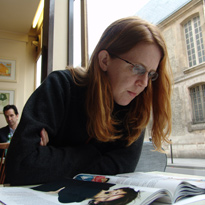
Documentary
Reasonable Doubt This award-winning
documentary -- a co-production of CNN and the Center for Investigative
Reporting -- examined how problems at crime labs have contributed to
wrongful convictions across the country. I produced and wrote
Reasonable Doubt with CNN's Ken Shiffman, an amazing journalist, tutor,
and collaborator. Reasonable Doubt premiered January 9, 2005. Visit the
CNN and CIR web pages.
Writing
These Satellite Images Document an Atrocity: Researchers at AAAS and Amnesty International scramble to document destruction in Darfur -- and to protect villages at risk of imminent attack. This story is featured in Best of Technology Writing 2008. Washington Post Magazine This story is featured in Best of Technology Writing 2008.
CSI: TCP/IP: Keep your friends close and your enemies closer. Why the Pentagon's toughest Internet crime fighter likes hanging out with blackhat hackers. Wired
Grim Statistics: With an unprecedented countrywide survey of human-rights abuses, statisticians have calculated the tragic numbers from Sierra Leone's decade of civil war -- and pointed out who may be the most to blame. This three-page story is available online to Science subscribers. If you're not yet a subscriber, email me for more info.
Students Compete to Mount Best Defense Against Malicious Hackers: Late nights at the national collegiate cyber defense competition. Chronicle of Higher Education
Taking the Industry Road: When government science funding falls short, should academics turn to industry money? Nature
Emergency Care for the Undocumented: Federal law -- and the hippocratic oath -- dictate emergency treatment for all. What does this mean in practice? Annals of Emmergency Medicine
Hollywood Undercover: Movies at the DOD's annual cyber crime conference. Wired
Taxes Made Tolerable: A new program can help thousands of low-income workers do their taxes. So what's the holdup? Mother Jones
Firearm Forensics A fired gun can leave residues on a shooter's hands -- but so can a ride in a patrol car. This piece ran months before the FBI stopped testing for gunshot residue, and also before the first time the test was excluded from a trial in by a US judge. New Scientist
I Went to this Hacker Conference. . . What happens when thousands of security geeks converge on Las Vegas? Digital blood spills at a 34-hour hacking competition in Sin City. Popular Science.
Fate or Foul Play? A hospital staffer thought he could kill patients without leaving a trace. A supersensitive new toxicology test proved him wrong. Popular Science.
Science Casts Doubt on FBI's Bullet Evidence: This front page story ran February 3, 2003 in the Los Angeles Times. It was picked up by several major dailies, including the Chicago Tribune. To read it, please go to the Center for Investigative Reporting web site.
Chemical Matching of Bullets Fatally Flawed: Crime scene slugs are frequently linked to suspects using trace element analysis -- new research shows this is impossible. New Scientist.
Addictive Research: Cocaine hijackers and other adventures in neuroscience. A profile of Dr. Susan Amara. Pitt Med
A Brief History of the Celibate Priesthood: Until the 11th century, the Catholic Church did not ban marriage for priests. Even today, a few married priests serve, even while their brethren have been forced out. El Andar.
Also... one of my first writing jobs was as a contributor to the college textbook Agroecology: Ecological Processes in Sustainable Agriculture, published by Ann Arbor Press.
